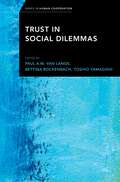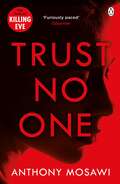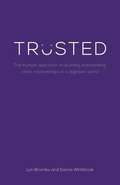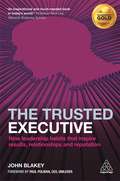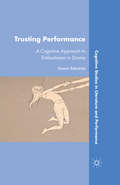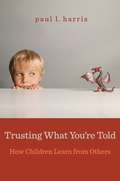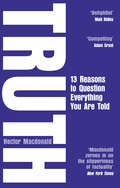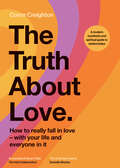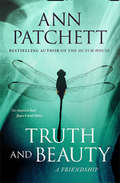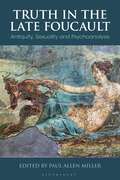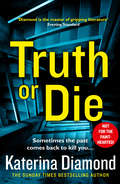- Table View
- List View
Trust in Social Dilemmas (Series in Human Cooperation)
by Toshio Yamagishi Paul A. M. Van Lange Bettina RockenbachOne of the key scientific challenges is the puzzle of human cooperation. Why do people cooperate with one another? What causes individuals to lend a helping hand to a stranger, even if it comes at a major cost to their own well-being? Why do people severely punish those who violate social norms and undermine the collective interest? Edited by Paul A.M. Van Lange, Bettina Rockenbach, and Toshio Yamagishi, Trust in Social Dilemmas carefully considers the role of trust in establishing, promoting, and maintaining overall human cooperation. By exploring the impact of trust and effective cooperation on relationships, organizations, and communities, Trust in Social Dilemmas draws inspiration from the fact that social dilemmas, defined in terms of conflicts between self-interest and the collective interest, are omnipresent in today's society. In capturing the breadth and relevance of trust to social dilemmas and human cooperation more generally, this book is structured in three effective parts for readers: the biology and development of trust; the importance of trust for groups and organizations; and how trust factors across the overall health of today's society. As Van Lange, Rockenbach, Yamagishi, and their team of expert contributors all explore in this compelling new volume, there is little doubt that trust and cooperation are intimately related in most - if not all - of our social dilemmas.
Trust in Social Dilemmas (Series in Human Cooperation)
One of the key scientific challenges is the puzzle of human cooperation. Why do people cooperate with one another? What causes individuals to lend a helping hand to a stranger, even if it comes at a major cost to their own well-being? Why do people severely punish those who violate social norms and undermine the collective interest? Edited by Paul A.M. Van Lange, Bettina Rockenbach, and Toshio Yamagishi, Trust in Social Dilemmas carefully considers the role of trust in establishing, promoting, and maintaining overall human cooperation. By exploring the impact of trust and effective cooperation on relationships, organizations, and communities, Trust in Social Dilemmas draws inspiration from the fact that social dilemmas, defined in terms of conflicts between self-interest and the collective interest, are omnipresent in today's society. In capturing the breadth and relevance of trust to social dilemmas and human cooperation more generally, this book is structured in three effective parts for readers: the biology and development of trust; the importance of trust for groups and organizations; and how trust factors across the overall health of today's society. As Van Lange, Rockenbach, Yamagishi, and their team of expert contributors all explore in this compelling new volume, there is little doubt that trust and cooperation are intimately related in most - if not all - of our social dilemmas.
Trust No One: I Am Pilgrim meets Orphan X in this explosive thriller. You won't be able to put it down
by Anthony MosawiI Am Pilgrim meets Orphan X in TRUST NO ONE, a high-concept read that grips and entertains like a Hollywood thrillerTHEY FOUND HER WHEN SHE WAS TEN. Locked in a sensory-deprivation tank. Trapped for days in the dark. Listening to the same message over and over: 'My name is Sara Eden. My name is Sara Eden.Her memory gone, this is all Sara knows about herself. There were a handful of clues. A battered necklace. A few scraps of paper. And a polaroid of a stranger with a handwritten note: 'Don't trust this man'.Now an adult, Sara knows a few more things. That the government agents pursuing her will never stop. And that the only path to her identity is to find the man she must not trust. But there is something else in Sara's past that is more dangerous, more deadly, than her pursuers. And the only thing she knows for certain is that she mustTRUST NO ONE
Trusted: The Human Approach To Building Outstanding Client Relationships In A Digitised World (PDF)
by Lyn Bromley Donna WhitbrookIn a world of increasingly digitised interactions it’s more essential than ever for businesses to connect with their customers and staff on a human level. Trusted gives clear strategies to build and maintain deep professional relationships, authentically. The revolutionary T-spot model explores the five essential areas that must be aligned to create professional trust - mindset, communication, interaction, behaviour and professional image - and reveals where the ‘credibility thief’ is damaging that trust and, ultimately, your profits. Beautifully designed with concepts illustrated visually throughout, Trusted is full of inspirational ideas, top tips and insights drawn from the authors’ work with world-class organisations. It shows leaders how to focus on the skills that impact on the client experience and the company’s ability to deliver outstanding service, resulting in improved profits, employee retention, company growth and competitive advantage.
The Trusted Executive: Nine Leadership Habits That Inspire Results, Relationships And Reputation
by John BlakeyThe Trusted Executive helps leaders create a strategy for building trust in a globalized, technology-enabled, diverse and increasingly sceptical world. Through innovative coaching exercises, self-assessment exercises, inspirational interviews with international CEOs and underpinned by rigorous academic research, The Trusted Executive gives leaders the tools to build trust through three key pillars: ability, integrity and benevolence. Underpinning these pillars lie nine habits of trustworthiness; habits that will enable executives to deliver outstanding results, inspiring relationships and a positive contribution to society. With tools for measuring and developing leadership trust and focused strategies for handling trust violations, The Trusted Executive takes account of the ever-changing, increasingly diverse and multi-generational work environment. An essential tool for leaders who want to create a positive long-term legacy. 9780749474232 9780749474225
Trusting Performance: A Cognitive Approach to Embodiment in Drama (Cognitive Studies in Literature and Performance)
by N. RokotnitzAn epistemological inquiry into the dynamics of interpersonal trust-relations, combining philosophy, science, and critical theory in the analysis of performing bodies - on stage and in life. Rokotnitz argues for the exploration of drama as a conduit to emotional learning that can change the somatic identity of performers and audiences alike.
Trusting What You're Told: How Children Learn from Others
by Paul L. HarrisIf children were little scientists who learn best through firsthand observations and mini-experiments, how would a child discover that the earth is round—never mind conceive of heaven as a place someone might go after death? Trusting What You’re Told begins by reminding us of a basic truth: Most of what we know we learned from others.
Trusting What You're Told: How Children Learn from Others
by Paul L. HarrisIf children were little scientists who learn best through firsthand observations and mini-experiments, how would a child discover that the earth is round—never mind conceive of heaven as a place someone might go after death? Trusting What You’re Told begins by reminding us of a basic truth: Most of what we know we learned from others.
Truth: How the Many Sides to Every Story Shape Our Reality
by Hector Macdonald'Macdonald zeros in on the slipperiness of factuality, offering an array of case studies from the worlds of history, commerce and – of course – politics.'New York Times Book ReviewFor fans of Nudge, Black Box Thinking and The Art of Thinking Clearly, a fascinating dive into the many ways in which ‘competing truths’ shape our opinions, behaviours and beliefs.True or false? It’s rarely that simple.There is more than one truth about most things. Eating meat is nutritious but it’s also damaging to the environment. The Internet disseminates knowledge but it also spreads hatred. As communicators, we select the truths that are most useful to our agenda.We can select truths constructively to inspire organisations, encourage children, and drive progressive change. Or we can select truths that give a false impression of reality, misleading people without actually lying. Others can do the same, motivating or deceiving us with the truth. Truths are neutral but can also be highly versatile tools that we can use for good or ill.Hector Macdonald here explores how truth is used and abused in politics, business, the media and everyday life. Combining great storytelling with practical takeaways and a litany of fascinating, funny and insightful case studies, Truth is a sobering and engaging read about how profoundly our mindsets and actions are influenced by the truths that those around us choose to tell.
The Truth About Burnout: How Organizations Cause Personal Stress and What to Do About It
by Christina Maslach Michael P. LeiterToday's workforce is experiencing job burnout in epidemic proportions. Workers at all levels, both white- and blue-collar, feel stressed out, insecure, misunderstood, undervalued, and alienated at their workplace. This original and important book debunks the common myth that when workers suffer job burnout they are solely responsible for their fatigue, anger, and don't give a damn attitude. The book clearly shows where the accountability often belongs. . . .squarely on the shoulders of the organization.
The Truth about Language: What It Is and Where It Came From
by Michael C. CorballisEvolutionary science has long viewed language as, basically, a fortunate accident—a crossing of wires that happened to be extraordinarily useful, setting humans apart from other animals and onto a trajectory that would see their brains (and the products of those brains) become increasingly complex. But as Michael C. Corballis shows in The Truth about Language, it’s time to reconsider those assumptions. Language, he argues, is not the product of some “big bang” 60,000 years ago, but rather the result of a typically slow process of evolution with roots in elements of grammatical language found much farther back in our evolutionary history. Language, Corballis explains, evolved as a way to share thoughts—and, crucially for human development, to connect our own “mental time travel,” our imagining of events and people that are not right in front of us, to that of other people. We share that ability with other animals, but it was the development of language that made it powerful: it led to our ability to imagine other perspectives, to imagine ourselves in the minds of others, a development that, by easing social interaction, proved to be an extraordinary evolutionary advantage. Even as his thesis challenges such giants as Chomsky and Stephen Jay Gould, Corballis writes accessibly and wittily, filling his account with unforgettable anecdotes and fascinating historical examples. The result is a book that’s perfect both for deep engagement and as brilliant fodder for that lightest of all forms of language, cocktail party chatter.
The Truth about Language: What It Is and Where It Came From
by Michael C. CorballisEvolutionary science has long viewed language as, basically, a fortunate accident—a crossing of wires that happened to be extraordinarily useful, setting humans apart from other animals and onto a trajectory that would see their brains (and the products of those brains) become increasingly complex. But as Michael C. Corballis shows in The Truth about Language, it’s time to reconsider those assumptions. Language, he argues, is not the product of some “big bang” 60,000 years ago, but rather the result of a typically slow process of evolution with roots in elements of grammatical language found much farther back in our evolutionary history. Language, Corballis explains, evolved as a way to share thoughts—and, crucially for human development, to connect our own “mental time travel,” our imagining of events and people that are not right in front of us, to that of other people. We share that ability with other animals, but it was the development of language that made it powerful: it led to our ability to imagine other perspectives, to imagine ourselves in the minds of others, a development that, by easing social interaction, proved to be an extraordinary evolutionary advantage. Even as his thesis challenges such giants as Chomsky and Stephen Jay Gould, Corballis writes accessibly and wittily, filling his account with unforgettable anecdotes and fascinating historical examples. The result is a book that’s perfect both for deep engagement and as brilliant fodder for that lightest of all forms of language, cocktail party chatter.
The Truth about Language: What It Is and Where It Came From
by Michael C. CorballisEvolutionary science has long viewed language as, basically, a fortunate accident—a crossing of wires that happened to be extraordinarily useful, setting humans apart from other animals and onto a trajectory that would see their brains (and the products of those brains) become increasingly complex. But as Michael C. Corballis shows in The Truth about Language, it’s time to reconsider those assumptions. Language, he argues, is not the product of some “big bang” 60,000 years ago, but rather the result of a typically slow process of evolution with roots in elements of grammatical language found much farther back in our evolutionary history. Language, Corballis explains, evolved as a way to share thoughts—and, crucially for human development, to connect our own “mental time travel,” our imagining of events and people that are not right in front of us, to that of other people. We share that ability with other animals, but it was the development of language that made it powerful: it led to our ability to imagine other perspectives, to imagine ourselves in the minds of others, a development that, by easing social interaction, proved to be an extraordinary evolutionary advantage. Even as his thesis challenges such giants as Chomsky and Stephen Jay Gould, Corballis writes accessibly and wittily, filling his account with unforgettable anecdotes and fascinating historical examples. The result is a book that’s perfect both for deep engagement and as brilliant fodder for that lightest of all forms of language, cocktail party chatter.
The Truth about Language: What It Is and Where It Came From
by Michael C. CorballisEvolutionary science has long viewed language as, basically, a fortunate accident—a crossing of wires that happened to be extraordinarily useful, setting humans apart from other animals and onto a trajectory that would see their brains (and the products of those brains) become increasingly complex. But as Michael C. Corballis shows in The Truth about Language, it’s time to reconsider those assumptions. Language, he argues, is not the product of some “big bang” 60,000 years ago, but rather the result of a typically slow process of evolution with roots in elements of grammatical language found much farther back in our evolutionary history. Language, Corballis explains, evolved as a way to share thoughts—and, crucially for human development, to connect our own “mental time travel,” our imagining of events and people that are not right in front of us, to that of other people. We share that ability with other animals, but it was the development of language that made it powerful: it led to our ability to imagine other perspectives, to imagine ourselves in the minds of others, a development that, by easing social interaction, proved to be an extraordinary evolutionary advantage. Even as his thesis challenges such giants as Chomsky and Stephen Jay Gould, Corballis writes accessibly and wittily, filling his account with unforgettable anecdotes and fascinating historical examples. The result is a book that’s perfect both for deep engagement and as brilliant fodder for that lightest of all forms of language, cocktail party chatter.
The Truth About Lies: A Taxonomy of Deceit, Hoaxes and Cons
by Aja RadenFibbing, prevaricating, stretching the truth, white lies, of omission, of commission. Lying is so pervasive that we have countless words for it. But have you ever considered why you believed a lie you were told - or why we lie at all? In this witty, whirlwind tour through the annuls of deceit, bestselling author Aja Raden combines psychology, popular science and history to explore everything you've ever wanted to know about manipulation and lying, showing how it evolved and why even the birds and the bees do it. From 'big lies' like the English gent who invented a South American country to pyramid schemes like Bernie Madoff, this is an eye-opening primer that decodes how we behave and function, and reveals how lying shapes our experience of the world around us.
The Truth About Love: How to really fall in love - with your life and everyone in it
by Conor CreightonWe are trained from the youngest of ages to imagine that love is a force outside of ourselves; that if you keep swiping, one day your prince will come; that love is something you have to look for, work for, diet for.The truth is: we are creators of love, not discoverers of love, and until we realise that love comes out of us, rather than to us, we’ll never really get it or feel it.Conor Creighton learned this the hard way with a string of tumultuous relationships in his past. That was until, through meditation, he woke up to the powerful force that is self-love and watched as his relationships and the whole world transformed around him.In a unique hybrid of memoir and self-help, here Conor uses his life lessons to help readers wake up to the truth about love. A modern manifesto and spiritual guide to relationships, The Truth About Love makes a daring call to action, showing how to change yourself and the world around you through the courageous act of opening your heart.
The Truth about Trauma and Dissociation: Everything You Didn't Want to Know and Were Afraid to Ask
by Valerie SinasonAn accessible and sensitive guide to the key concepts involved when working with people who have experienced trauma and dissociation, this book covers all degrees of trauma: complex, childhood attachment ruptures, sexual abuse, torture, war, and even the coronavirus pandemic. Through this compassionate and intelligent work, Valerie Sinason shows us what is needed to understand some of the worst possible experiences without a loss of feelings.
Truth and Beauty: A Friendship
by Ann PatchettBestselling author and Orange Prize winner Ann Patchett’s first work of non-fiction is a searing, emotionally wrenching account of her long friendship with the critically acclaimed, and recently deceased author, Lucy Grealy.
Truth and the Unconscious in Psychoanalysis (The New Library of Psychoanalysis)
by Giuseppe CivitareseWhat is the truth of the unconscious? Truth and the Unconscious in Psychoanalysis explores the intersection of these two concepts within a Bionian framework. Giuseppe Civitarese maps out the unconscious in psychoanalysis, and focuses on the differences between the Freudian, Kleinian, Bionian and Lacanian schools of thought on this topic, as well as drawing on findings from neuroscience. The book explores topics including the inaccessibility of the unconscious, dreams, body issues, issues of personality, the influence of field theory and the clinical implications of this theorising. It contains innovative comparison between Freudian metapsychology and the Bionian theory on thinking, and novel use of Bion's hallucinosis as an important new technical tool. An internationally recognised author, Civitarese provides fresh ideas throughout on a challenging subject, supported with vivid clinical material. Truth and the Unconscious in Psychoanalysis will be of interest to anyone following the growing post-Bionian movement within contemporary psychoanalysis, enabling them to familiarize themselves with some of the most important current issues in psychoanalytic research. Truth and the Unconscious in Psychoanalysis will appeal to psychotherapists, psychologists and psychoanalysts, as well as undergraduate and postgraduate students studying in the field.
Truth and the Unconscious in Psychoanalysis (The New Library of Psychoanalysis)
by Giuseppe CivitareseWhat is the truth of the unconscious? Truth and the Unconscious in Psychoanalysis explores the intersection of these two concepts within a Bionian framework. Giuseppe Civitarese maps out the unconscious in psychoanalysis, and focuses on the differences between the Freudian, Kleinian, Bionian and Lacanian schools of thought on this topic, as well as drawing on findings from neuroscience. The book explores topics including the inaccessibility of the unconscious, dreams, body issues, issues of personality, the influence of field theory and the clinical implications of this theorising. It contains innovative comparison between Freudian metapsychology and the Bionian theory on thinking, and novel use of Bion's hallucinosis as an important new technical tool. An internationally recognised author, Civitarese provides fresh ideas throughout on a challenging subject, supported with vivid clinical material. Truth and the Unconscious in Psychoanalysis will be of interest to anyone following the growing post-Bionian movement within contemporary psychoanalysis, enabling them to familiarize themselves with some of the most important current issues in psychoanalytic research. Truth and the Unconscious in Psychoanalysis will appeal to psychotherapists, psychologists and psychoanalysts, as well as undergraduate and postgraduate students studying in the field.
Truth in Fiction: Rethinking its Logic (Synthese Library #391)
by John WoodsThis monograph examines truth in fiction by applying the techniques of a naturalized logic of human cognitive practices. The author structures his project around two focal questions. What would it take to write a book about truth in literary discourse with reasonable promise of getting it right? What would it take to write a book about truth in fiction as true to the facts of lived literary experience as objectivity allows?It is argued that the most semantically distinctive feature of the sentences of fiction is that they areunambiguously true and false together. It is true that Sherlock Holmes lived at 221B Baker Street and also concurrently false that he did. A second distinctive feature of fiction is that the reader at large knows of this inconsistency and isn’t in the least cognitively molested by it. Why, it is asked, would this be so? What would explain it?Two answers are developed. According to the no-contradiction thesis, the semantically tangled sentences of fiction are indeed logically inconsistent but not logically contradictory. According to the no-bother thesis, if the inconsistencies of fiction were contradictory, a properly contrived logic for the rational management of inconsistency would explain why readers at large are not thrown off cognitive stride by their embrace of those contradictions. As developed here, the account of fiction suggests the presence of an underlying three - or four-valued dialethic logic. The author shows this to be a mistaken impression. There are only two truth-values in his logic of fiction.The naturalized logic of Truth in Fiction jettisons some of the standard assumptions and analytical tools of contemporary philosophy, chiefly because the neurotypical linguistic and cognitive behaviour of humanity at large is at variance with them. Using the resources of a causal response epistemology in tandem with the naturalized logic, the theory produced here is data-driven, empirically sensitive, and open to a circumspect collaboration with the empirical sciences of language and cognition.
Truth in the Late Foucault: Antiquity, Sexuality, and Psychoanalysis (Bloomsbury Studies in Classical Reception)
by Paul Allen MillerThe first full treatment of truth as a core philosophical concept in the late Foucault, this volume examines his work on the ancient world and the early church. Each essay features a deep examination as to how the topics of truth and sexuality intersect with and focus on Foucault's engagement with ancient philosophy and thought. Truth in the Late Foucault offers readings on Plato, Artemidorus, Cicero, Sophocles and the Stoics, and pays close attention to Cassian, Paulinus of Nola, and early Christian practices of confession. With the publication of the long-awaited volume 4 of the History of Sexuality: Confessions of the Flesh, the shape of the final Foucault is now brought into stark relief. As well as looking at ancient thought, the contributors explore Foucault's work in relation to philosophers such as Gadamer, Heidegger, Derrida and Descartes. Foucault's long-running and often contentious dialogue with psychoanalysis, on the relation between truth and the subject, is also examined. Each essay not only makes an important statement, but also is part of an interconnected arc of topics and understanding, covering both the ancient and modern periods. This book reveals that Foucault's concern with antiquity raises questions deeply pertinent to the present moment.
Truth in the Late Foucault: Antiquity, Sexuality, and Psychoanalysis (Bloomsbury Studies in Classical Reception)
The first full treatment of truth as a core philosophical concept in the late Foucault, this volume examines his work on the ancient world and the early church. Each essay features a deep examination as to how the topics of truth and sexuality intersect with and focus on Foucault's engagement with ancient philosophy and thought. Truth in the Late Foucault offers readings on Plato, Artemidorus, Cicero, Sophocles and the Stoics, and pays close attention to Cassian, Paulinus of Nola, and early Christian practices of confession. With the publication of the long-awaited volume 4 of the History of Sexuality: Confessions of the Flesh, the shape of the final Foucault is now brought into stark relief. As well as looking at ancient thought, the contributors explore Foucault's work in relation to philosophers such as Gadamer, Heidegger, Derrida and Descartes. Foucault's long-running and often contentious dialogue with psychoanalysis, on the relation between truth and the subject, is also examined. Each essay not only makes an important statement, but also is part of an interconnected arc of topics and understanding, covering both the ancient and modern periods. This book reveals that Foucault's concern with antiquity raises questions deeply pertinent to the present moment.
Truth or Die: Sometimes The Past Comes Back To Kill You
by Katerina DiamondThe #1 bestseller is back with a twisty crime thriller, perfect for fans of Karin Slaughter and Angela Marsons. ‘All hail the new Queen of Crime’ Heat
Truth, Reality and the Psychoanalyst: Latin American Contributions to Psychoanalysis
by Silvia FlechnerPsychoanalysis has long thrived in Latin America. Like the rest of the psychoanalytic world, our Latin American colleagues are diverse in their thinking, but there is nevertheless a distinct cultural voice with which they speak. Unfortunately, language barriers have interfered with the communication of this unique and highly sophisticated way of thinking to colleagues around the world. This stimulating new volume goes a long way to fill this void by presenting a collection of essays that present Latin American psychoanalysis at its best. An added treat is the cross-cultural dialogue provided by commentators for each chapter from other psychoanalytic cultures. I highly recommend this exciting new contribution to both candidates and experienced analysts.
